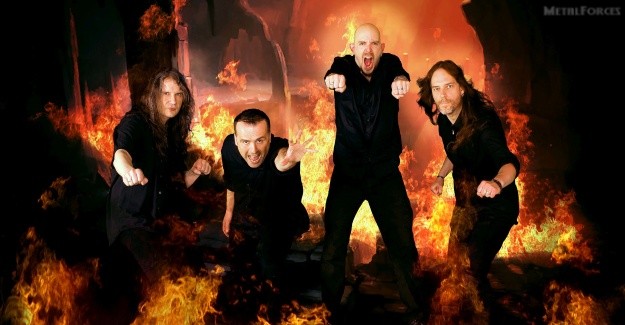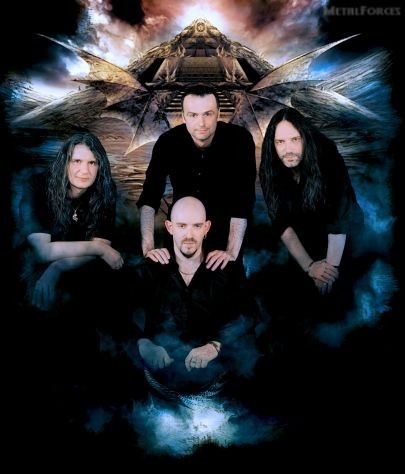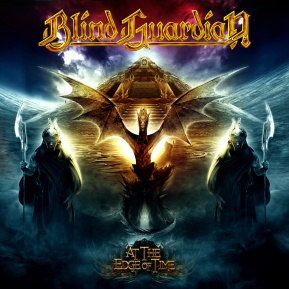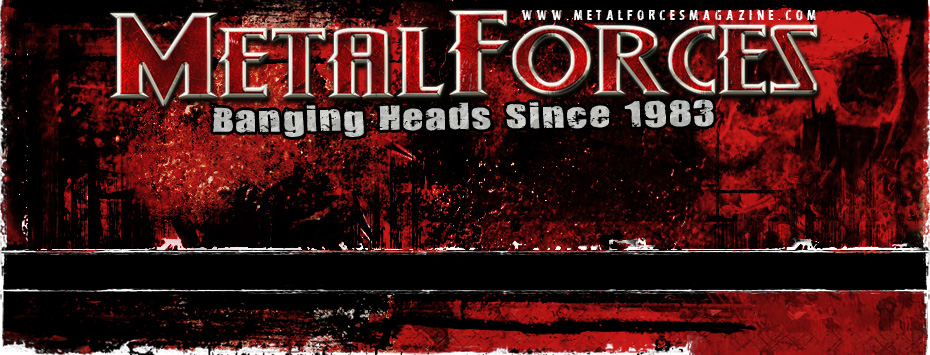
BLIND GUARDIAN – A Voice In The Dark
Anthony Morgan
August 2010
 Blind Guardian (l-r): André Olbrich, Hansi Kursch, Frederik Ehmke and Marcus Siepen |
![]()
To accompany the soundtrack for role-playing video game Sacred 2 – Fallen Angel, German power metal outfit Blind Guardian were asked to pen a composition. A classical affair aptly named ‘Sacred’, the track was unveiled by the group at the Role Play Convention in Münster, Germany on the weekend of April 26-27th, 2008. The game itself underwent issue in November 2008 through Microsoft Windows PC, and subsequently May-June 2009 via the Playstation 3 and Xbox 360. ‘Sacred’ would provide the initial framework for Blind Guardian’s July 2010 studio full-length At The Edge Of Time – their ninth overall – the tune being rewritten and renamed ‘Sacred Worlds’.
“We started songwriting right after finishing touring for A Twist In The Myth (September 2006),” explains Hansi Kürsch, lead vocalist of Blind Guardian. “We had been forced into that situation due to the fact that we were invited to do music for a computer game called Sacred 2: Fallen Angel. We were able to write a song for that computer game very quickly, and later on it became the soundtrack for the game as well – it has been a fairly successful game. Due to that song (‘Sacred Worlds’), we were confident and convinced that we would have at least one classical Blind Guardian song on the album with a lot of epic elements, orchestral elements and all that stuff. It gave us good grounding for the rest of the songwriting period, so we immediately followed that up with more songs and completed songs in a pretty fluent and stable way.
“There was a little bit of a classical element, a little bit of a progressive element, modern elements, and more back-to-the-roots type elements. In general, there’s very solid, melodic, really catchy elements in all the songs we wrote up to that point. It was then time to start the production, which we did from October 2009 to April 2010 in our own studio, the Twilight Hall Studio in Grefrath-Oedt which is close to our hometown. We worked with Charlie Bauerfeind who added some traditional ideas to the material, and that improved the quality of the songs. We were able to establish a very modern sound that was very suitable for the quality of the songs. In general, the album has a very diverse selection of different songs; all very individual, all containing a lot of melodies, and all having high potential in terms of quality I would say.”
Charlie Bauerfeind’s relationship with Blind Guardian commenced with sixth studio full-length Nightfall In Middle-Earth (April 1998), which the man engineered. The producer’s chair beckoned with March 2002’s A Night At The Opera and the aforementioned A Twist In The Myth. “Charlie is a friend, and can be considered to be the fifth member,” the singer feels. “This is the fourth studio album we have worked with him on, so he has a very good understanding about what the philosophy behind Blind Guardian’s music is, and he has a very clear vision of how an album should sound. He came up with very interesting ideas for this particular production, so he can be seen as a conductor in terms of bringing the music, the lyrics, the performances of the individual musicians, and the organisation of all the necessary people who are involved in such an event together.
“It’s a very important part he has taken, and that part has developed over the years; while he was more of an advisor when we recorded Nightfall In Middle-Earth, he was – for the first time – the main engineer and producer when we recorded A Night At The Opera, but still we were in full control. When we recorded A Twist In The Myth it was a democratic decision between us and him as producer, while on At The Edge Of Time he was certainly the driving force and the leading force.”
Ninth studio outing At The Edge Of Time was made available for purchase in July 2010, almost four years following the issue of its predecessor. Listeners could theorise that Blind Guardian has more quality control measures in place than its peers, the assortment taking its time as opposed to rush releasing material. “Generally speaking, I’m fairly convinced that this is the case, that we do have more layers and more levels in our music than general bands do,” Hansi agrees. “For us, I also think that it is essential to have all our songs individually speak a different language so that people have something to discover. Other bands, in many cases, choose one definite direction in the early stages of their career, using that for each album. That’s not the case with us, so there’s certainly a significant difference. If you really delve into each part and observe them more deeply, you would notice that there are so many elements which other bands wouldn’t even consider using. There is that difference when it comes to Blind Guardian’s songwriting when you compare it to, let’s say 96%, of all the other bands around.”

|
Albeit a minute influence, thrash elements feature on At The Edge Of Time. “I consider that to be very early 90s, late 80s related,” the frontman comments. “There are traditional thrash melodies and speed elements we’ve brought in. The album is also certainly influenced by bands like Slayer, Testament, Forbidden, Flotsam and Jetsam, which were minor influences and inspirations when we were working on these particular songs.”
And as well, orchestral and epic moments also feature. “The synergy and the mingling of an orchestra playing together with a band becomes most obvious with ‘Wheel Of Time’ and ‘Sacred Worlds’, the songs we called ‘the real orchestra in track form’,” Hansi believes. “They are pretty Oriental oriented and have the momentum of Wagner’s classical music as well as Vivaldi’s joy of playing in general, so they are heavily influenced by the old classical composers and lend a more bombastic feeling to our music in comparison to other arrangements we’ve done. There were sounds for example on other songs where we already worked with orchestral arrangements, but it has become a more essential part of our music which made it absolutely necessary for us to transfer that to an organic sounding orchestra. It was very difficult to find people who have the ability to catch the band’s spirit, and at the same time, deliver that well-known classical atmosphere.”
In a press release issued for At The Edge Of Time, the Blind Guardian vocalist states that the quartet wants to ‘define [itself] with every release on a new level’. “We’re different now, I would say,” he surmises, questioned as to whether Blind Guardian has achieved that with their July 2010 opus. “Firstly, there’s our outlook on the near future, which would be the more classical approach as can be heard on ‘Sacred Worlds’ or on ‘Wheel Of Time’. We have then incorporated some elements which we have not used so drastically as on At The Edge Of Time, which would be the Oriental approach on ‘Wheel Of Time’ again or the more power ballad approach of ‘War Of The Thrones’ – for the first time, we worked on vocals for a ballad in the heaviest way.
“Production-wise and songwriting-wise, you have a way of treating such things. The next step would certainly then be the mingling of the old qualities, which are a little bit of A Twist In The Myth and partly A Night At The Opera again with the new elements. Therefore, I think the direction Blind Guardian has taken after Nightfall In Middle-Earth has taken shape but without denying the past. Of course, on a certain level it is the progressive design of songs like ‘Valkyries’ for example.”
Inaugural single ‘A Voice In The Dark’ was inspired by George R.R. Martin’s A Song Of Ice And Fire saga, touching upon the character of Bran Stark. “In general, it’s the music which comes first with Blind Guardian,” Hansi reveals. “We do not really talk about lyrical topics or the direction the lyrics will go, so in general, we just look for a potentially good idea to work on. When we did ‘A Voice In The Dark’, it obviously had this very significant and very intense, fresh pattern from the beginning which André (Olbrich, lead guitar) came up with. I followed up with my melody lines and so on until the point when we design the chorus of the song, which worked surprisingly fluent on that one. I came up with the ‘Man in the dark’ line which can be heard on the demo version, and at that point, I had already figured that it might make sense to go into a darker, George R.R. Martin related direction.
“I’ve read his stories over the last three years, and I was really thrilled by the developments, by the way he treats his characters. I thought his stories were grand, and this was my first attempt to do something connected to the A Song Of Ice And Fire saga. I thought it would be a good idea to write a song about his (Bran Stark’s) emotions during his downfall, writing about why this is supposed to happen, saying that you have to live with the consequences of the downfall, of the smashing to the ground. You have to live through your visions, and then you won’t completely fade away. That was basically the message behind it.”
A music video for ‘A Voice In The Dark’ was filmed in Belgrade, Serbia. “These are the same guys we worked with for ‘Another Stranger Me’ – which totally amazed us back then – so they were the obvious choice for us,” the mainman reckons. “The guys were aware of the lyrical subject and the storyboard, and how we needed it filmed. They were thrilled by his downfall, and by the visions created by that downfall. They looked up the regular storyboard of George R.R. Martin’s A Song Of Ice And Fire, and they delivered that through a completely different direction.
“I think that what art, music and literature is made for in general is to spawn inspiration and interpretations, so that new art is created. They came up with the idea of involving the pyramid, which is an element of the album cover, and creating a story combining the downfall and the pyramid. They came up with the idea to have an ancient sacrifice to ensure that the circle of life will continue, and basically you see the sacrifice and downfall – which repeats itself continuously.”
George R.R. Martin aside, other writers who inspired lyrics for the album include Michael Moorcock, Peter S. Beagle, Robert Jordan, and John Milton. “That’s a tradition,” Hansi acknowledges. “I’m mostly inspired by stories I’ve read over the years, and this was the case for At The Edge Of Time as well. As I mentioned though, it’s very important to keep in mind that the music always comes first. I think the narrative element in the music, the picture it creates, defines the lyrical direction. I then undertake very deep research for the stories or elements of the story which I find suitable, and it’s also important to know what I’m creating out of it because my personal perspective and the interpretation or analysis that is done for a certain story will be written in as well.
“Other important inspirations were Peter S. Beagle, who wrote a story called The Innkeeper’s Song, which had an impact on ‘Road Of No Release’. Of course, Robert Jordan’s Wheel Of Time series was a strong influence as well as Michael Moorcock again. So was John Milton with his poem Paradise Lost as well as his political writing The Tenure Of Kings And Magistrates.”

|
Felipe Machado Franco designed At The Edge Of Time’s cover artwork, meanwhile. “Again, it’s all about inspiration,” the singer reminds. “I gave Felipe several instructions for the album cover artwork, and he of course had suitable ideas for my creation of a Latin American pyramid, which is considered to be an intervention between all timelines. He in general was very thrilled by the concept of different timelines coming together at that point. I also instructed him to come up with a water dragon statue in front of this pyramid, and he took it from there and created his own image and his own ideas of it.
“I was immediately blown away by his creation out of a few lines I gave him. He certainly can be seen to be the driving force behind the concept from that point on. He also suggested coming up with a booklet containing artwork for each and every individual song, and the same thing happened again. I gave him ideas about particular situations in the storyboards of the lyrics which I felt had the most potential in artwork form, and he then immediately would set out and always surprise me and amaze me with his ability to bring my ideas to visual life.”
The digipack edition of the record includes a cover interpretation of ‘You’re The Voice’, originally performed by John Farnham. “There were many reasons we decided to cover that song,” Hansi discloses. “One, certainly based on our past as metalheads and the experience we felt in the late 80s when this song finally changed our minds about mainstream rock music. We really loved the song, and were completely blown away and this sensation never really disappeared from any of the members. The chorus somehow speaks a certain Blind Guardian language I would say even, because it has that singalong quality. It was a very obvious choice for us, but when we started working on the song we didn’t think we’d have so many problems transforming the song into a proper Blind Guardian version. Of course, John Farnham is one of the best vocalists ever. This was enough motivation for me.”
“I think we’ve given justice to the original which is a very strong song and very well arranged,” he continues. “I also think we have paid tribute to Blind Guardian because it definitely does speak in a strong Blind Guardian language due to some more modern elements. We have delivered a fitting version for the new millennium, and I would say we have definitely given it a massive frame due to the great work of the rhythm guitars and the drums.”
Collaborating with Iced Earth mainman Jon Schaffer, as a part of Demons And Wizards Hansi issued a self-titled album (February 2000, SPV) and Touched By The Crimson King (June 2005, Warner). “It is unfortunately on hold,” the Blind Guardian co-founder affirms regarding the side project’s status. “Jon and I have spoken about it several times, so it’s not an off topic. I definitely would say we’re going to work on a third album. The question would be when the time would be right to do so. I hope that we might find the time within the next three years to songwrite so we could possibly release a third Demons & Wizards album in the year 2013. That would be my goal.”
“So far, I would say we have been a very lucky and very successful band,” the frontman says of Blind Guardian’s fortunes. “We’ve done some great music I would say, but you never know what to expect because the market in this scene is changing quickly day by day. I would say as long as we’re committed to music and we’re able to deliver passion throughout our music, we will be a constant part of the metal scene for the next ten to 20 years.”
At The Edge Of Time was released on July 29th, 2010 in Russia, on the 30th in Europe, on August 24th in the United States and in Japan on the 28th, all through Nuclear Blast Records.
Interview published in August 2010.
Related Posts via Categories
- BLIND GUARDIAN – The Tenth Wave (April 2015) | Features / Interviews @ Metal Forces Magazine
- SCOTTISH SICKNESS – A Report On The Scottish Death Metal Scene, Featuring BRAINBATH, PUTRID FATE And RANCID CADAVER (October 2022) | Features / Interviews @ Metal Forces
- LARVAE – Join The Hardcore Cult! (June 2022) | Features / Interviews @ Metal Forces Magazine
- TRENCH FOOT – Sacrificing Morals For Gory Obscenities (June 2022) | Features / Interviews @ Metal Forces Magazine
- L.A. GUNS – Trigger Happy (March 2019) | Features / Interviews @ Metal Forces Magazine
- CANCER – Crimes So Evil (November 2018) | Features / Interviews @ Metal Forces Magazine
- U.D.O. – The Tank Drives On (August 2018) | Features / Interviews @ Metal Forces Magazine
- SIEGE OF POWER – Bleeding For The Cause (August 2018) | Features / Interviews @ Metal Forces Magazine
- MOONSPELL – A Taste Of Live Eternity (August 2018) | Features / Interviews @ Metal Forces Magazine
- MONSTROSITY – Dark Matter Invocation (August 2018) | Features / Interviews @ Metal Forces Magazine
|
|





